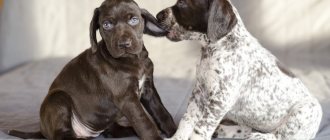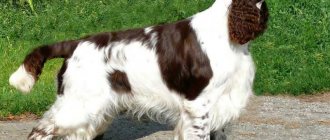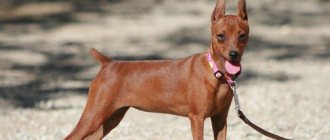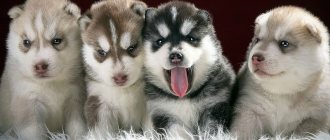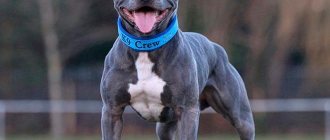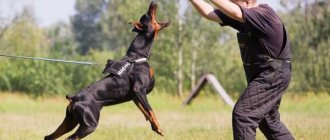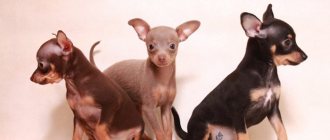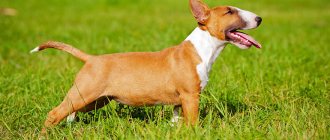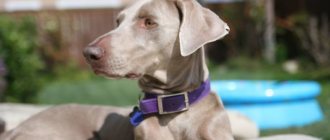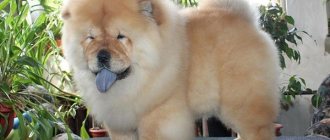What to feed the shorthaired pointer
Share this article
Feeding is considered one of the most important parts of daily dog care. When compiling a diet for shorthaired pointer, it is necessary to take into account that the rules of feeding animals differ significantly from human ones.
- What can a shorthaired pointer eat? Menu for adults Dry food
- What is prohibited
Feeding a shorthaired pointer puppy
Moving to a new family for a shorthaired pointer baby, as well as for a St. Bernard puppy , is very stressful.
Just yesterday he was busy with his brothers and sisters under his mother’s supervision, and today he is completely alone.
In the first days, the baby will be bored and anxious. To mitigate the situation, he needs to be given his usual food.
It is better not to introduce new products to the menu during the week.
Top level camouflage
Even changing the brand of dry food for puppies can lead to stomach upset.
To accustom the shorthaired pointer to new foods or types of food, you need to introduce unusual foods gradually.
To begin with, you can replace one feeding, and after a few days the second, until the animal gets used to the innovations.
As happens with Bernese Mountain Dog puppies , if the sale of Shorthaired Pointer puppies occurred after the first month of life, then dairy products cannot be avoided.
Low-fat milk, kefir and cottage cheese are suitable. Gradually, cheese and raw chicken eggs are introduced into the diet.
At three months of age, puppies are given boiled and raw meat. The best option is veal, beef, boneless chicken.
Pork is not suitable for dogs, especially for babies.
Meat does not need to be turned into minced meat, as it is less digestible. It's better to cut it into small pieces.
To grow and gain strength, shorthaired pointer cubs must receive a varied and balanced diet.
Important! For the glands responsible for metabolism to function properly, the puppy must receive at least 50 grams of raw meat daily.
At this age, children are introduced to boiled sea fish. Meat and fish are given along with porridge.
Any cereal is suitable except pearl barley. They need to be fortified with grated vegetables.
It is useful to add vitamins to food. And from 3 months of age you need to give 2 teaspoons of fish oil daily.
You should not feed puppies sharp bones, especially chicken bones. Babies do not know how to eat them and choke, and fragments of chicken bones can injure the puppy.
Shorthaired Pointer puppies love hunting. The hunting instinct is in their blood
Up to 2 months of age, puppies are fed 6 times a day, 4 months old - 5 times, 6 months old - 3 times.
A one-year-old shorthaired pointer is transferred to an adult diet and diet.
Feeding the shorthaired pointer with ready-made food simplifies the situation.
Special foods take into account the puppy’s need for all elements and vitamins.
Character traits
From birth, Shorthaired Pointers have a very developed protective instinct. Therefore, adult dogs become excellent watchdogs. They are suitable for keeping in a country house.
Animals are incredibly attached to their owner and all family members. They love constant attention and do not tolerate loneliness well. If you don't take care of socialization, dogs can grow up to be fearful or, conversely, aggressive. Like any hunting dog, the shorthaired pointer needs a strong, strong-willed and decisive owner. He must immediately show who is the boss of the house. At the same time, leadership cannot be demonstrated through physical assault and shouting: this will only intimidate the animal and make it uncontrollable.
The appearance of these active kids in the house is always accompanied by fun and pranks
Shorthaired Pointers have a highly developed intellect and have irrepressible energy. The combination of these qualities requires that the dog be busy with something all the time. Training is the best activity for distracting and developing the qualities of a dog. It is not only useful, but also brings joy to the animal.
Accustoming to neatness
If the little shorthaired pointer lived in a kennel, then he has no concept of neatness.
Breeders keep dogs on bedding that absorbs moisture. Puppies tend to go straight there.
But as soon as the baby comes into the house, you need to teach him to be neat.
Shorthaired pointers living in multi-storey buildings can be trained to walk on sand, straw or newspaper.
Important! You should not train your pet to wear diapers or rags. The little Kurt will quickly get used to it and will perceive any heap of clothes, carpet or sofa as a latrine.
As soon as the baby shorthaired pointer comes into the house, you need to teach him to be neat. Shorthaired pointers living in multi-storey buildings can be taught to walk on sand, straw or newspaper
As soon as the puppy starts to worry and look for a place to go to the toilet, you need to take him to the prepared sand.
After the baby does his business, he should be praised.
At night, from the “toilet” with sand to the sleeping area, you need to lay a “corridor” of screens so that the baby can only get on the sand.
After just 3-4 days, the puppy will get used to doing its business in the right place. Only the sand should always be clean and dry.
A serious disadvantage of this method is the difficulty in further training the puppy. After all, retraining is always more difficult.
At 3-4 months, the chicken should already be taught to fulfill its physiological needs on the street.
To do this, early in the morning, before he wakes up, he is taken out into the street.
If you repeat this procedure regularly 2-3 times a day, then by 6-8 months he will get used to doing all his business outside.
Shorthaired Pointer puppies are very cheerful companions. They show their joy with a smile like this
If it is possible to take your puppy outside often, then it is better to immediately teach him to do his business in the yard.
It is advisable to do this immediately after feeding and after sleep. Then he will quickly learn to ask to go outside at the right time.
What you should never do is scold your baby - he is not able to control his body like an adult dog.
Read more about how to train a dog to use the toilet outside: https://kot-pes.com/kak-sobaku-priuchit-k-tualetu-na-ulice/
Some puppy owners put up with puddles without risking taking their dog outside without vaccinations.
The fear of infecting your pet with infectious diseases is not a sufficient reason to leave it without walking.
On the contrary, in isolation the baby will develop worse and become sick.
Of course, it doesn’t hurt to be careful when walking shorthaired pointers. To prevent the animal from being bitten by a tick , it is worth wearing a special collar .
At 3-4 months, the chicken should already be taught to fulfill its physiological needs on the street. To do this, early in the morning, before he wakes up, he is taken out into the street. If you repeat this procedure regularly 2-3 times a day, then by 6-8 months he will get used to doing all his business outside
Mating and birth
Puberty begins at 8–12 months, and complete physical development occurs by 2–3 years. A physically healthy female dog goes into heat twice a year.
But there are dogs that are empty once a year or 3 times every 2 years. The emptying period lasts about 25 days. The main symptoms of its onset are swelling of the external part of the genital organ and bleeding. On the eighth day, the discharge decreases, and the bitch allows the male.
While stroking the dog with your hand, they check whether it is ready for mating with a male; when it is ready, it turns its tail to the side .
Important! The bitch and the dog must be on leashes when mating. If a girl bites, it is best to put a muzzle on her.
Coitus lasts approximately 15–20 minutes. You can repeat the mating a second time only after 24 hours have passed after the completion of the first one.
Gestation of puppies lasts 2 months, during which time the dog owner needs to prepare for the birth of puppies. The first thing to do is prepare an area for the puppies. A box or box is suitable for this, in which you need to lay a soft bedding. Several beddings should be prepared; they will become dirty. The second is items to help with delivery: scissors to cut the umbilical cord, a heating pad and a cloth to dry the puppies.
Childbirth in dogs lasts up to 24 hours. Before giving birth, the animal begins to behave nervously - fidgeting in its place, worrying. Prenatal contractions are accompanied by the release of mucus from the vagina. The puppy appears in a bubble, the mother must chew it, if this does not happen, then the owner must intervene.
As a rule, the dog itself licks the mucus from the puppy, but during the first birth it may become confused. Veterinarians advise stretching the bitch's nipples before giving birth - this will make it easier for newborns to suck on the breast. After giving birth, the animal needs to replace the bedding and attach the puppies to the chest.
Vaccinations for shorthaired pointer puppies
Up to 2 months, puppy owners do not have to worry about vaccinations.
Until this age, shorthaired pointer babies, like Cane Corso puppies, retain maternal immunity.
their first vaccinations at 2.5 months. I vaccinate shorthaired pointer against distemper, enteritis and hepatitis.
Before routine vaccinations, deworming should be carried out. It will need to be repeated periodically.
A single vaccination does not make it possible for a dog’s body to develop lasting immunity.
A whole range of activities is required, designed to last a year.
It is better to refrain from vaccinations during the change of teeth; this usually goes away in 4–5 months.
In the process of raising Shorthaired Pointers, you need to use the principle: reward more often for correct execution of the exercise, punish less for disobedience
Baby care
Before you bring a puppy into your home, you need to arrange its future home. Buy or make a bed out of an old box and blanket. Dogs of this breed do not tolerate dampness and drafts well. The sleeping place must be placed where it is dry and warm at any time of the year.
Take care of drinking and water bowls, toys, walking accessories and fur brushes. Buy hygiene products at the veterinary pharmacy. The breed is considered unpretentious, but basic care procedures will have to be performed. Moreover, the shorthaired pointer is accustomed to them “from a young age.”
These are smooth-haired dogs, but they shed a lot. The process is year-round, so you will have to comb it every day, starting from the moment the dog appears in the house.
The ears should be inspected weekly and wiped with a damp cloth. To treat the eyes, use a weak tea brew - do this once a week.
Raising a shorthaired pointer puppy
Friendliness, increased emotionality and energy are the main qualities of the shorthaired pointer breed.
Buying a puppy is not difficult, but raising it will require patience and composure.
Shorthaired Pointer cubs love to work with humans.
He will become a devoted friend in the house and a reliable assistant on the hunt if he is well raised and trained.
The goal of raising a Pointer is to develop positive qualities and suppress negative ones.
You need to start this work immediately after the puppy appears in the house, but little by little, in small portions.
At 4 months, the puppy's baby teeth begin to change. During this period, which can last up to a year and a half, the dog trains its teeth on various objects and chews on everything.
Important! The difficulties of raising temperamental dogs are just a myth. When training active breeds, stimulation is simply necessary.
In the process of raising Shorthaired Pointers, you need to use the principle: reward more often for correct execution of the exercise, punish less for disobedience.
As a reward, you can use cookies, candies, pieces of meat or any other treat.
They are so touching, these funny shorthaired pointer puppies.
Photos of these intelligent, easily trained and well-socialized dogs adorn the walls of hunters' homes.
They also quickly learn commands and happily carry out their owner’s orders.
Without a serious load, shorthaired pointer puppies can turn the whole house over. Its deficiency can lead to aggression, shyness or other deviations. But the puppy should not be overloaded. You need to leave him enough time to rest
Hunting Shorthaired Pointers must undergo indoor and field training . Companion dogs need good training.
At 6–8 months, puppies must come to the owner’s call, follow the prohibiting command, walk nearby, know the commands “place”, “lie down”, “sit”, “fetch”.
At 4 months, the puppy's baby teeth begin to change.
During this period, which can last up to one and a half years, the dog trains its teeth on various objects.
The puppy chews everything he sees. Punishment in the form of spanking will not help.
It’s better to keep your baby busy with toys and leave valuables where he can’t reach them.
You can read about how to make a dog toy with your own hands in the article
Shorthaired Pointer puppies discover themselves
Breed standard
German Pointers are very popular today in many countries. Naturally, standards have been defined that indicate that this is a purebred representative of the breed.
This is very important, since any admixture of foreign blood leads to defects in appearance, health, and behavioral characteristics. What are the standard characteristics of the shorthaired pointer breed ?
Kurzhaar runs
1. The male looks much more courageous and noticeably larger than the female - about 65 cm in height at the withers, weighing up to 30 kg. “Girls” look lighter, thinner and more graceful, grow up to 60 cm and are not so heavy - about 25 kg.
2. The coat lies tightly to the skin, is thick and shiny, short and harsh. Thoroughbreds have a wide variety of shades. From sandy and light brown to almost black (both without marks and with yellowish or dark spots, tan marks in different places).
3. The dog's head is small, elongated, shaped like a blunt wedge. The eyes are dark brown, clear, glowing with intelligence. The forehead is wide and protrudes slightly. The occipital protuberance stands out, but not very sharply. The ears are set high, hanging, rounded at the bottom, pressed to the muzzle.
4. A muscular, strong neck ends with a noble nape line.
5. The back of the smooth-haired German Pointer is straight, strong, and wide.
6. The tail is medium sized and high.
7. Paws are fairly long, feet are round, with thick pads and tightly clenched toes.
8. While chasing game, the dog gallops quickly, then starts to trot. Almost flying, moving easily and gracefully, with his head held high.
9. The following are considered defects:
- excessive tenderness of the physique;
- timidity;
- excessive viciousness;
- excessive nervousness;
- ambling or running sideways.
The shorthaired pointer in the photo looks confident and beautiful.
Exercise stress
Without serious loads, shorthaired pointer puppies can turn the whole house over.
This article will tell you what pets can do at home.
Its deficiency can lead to aggression, shyness or other deviations.
But the puppy should not be overloaded. You need to leave him enough time to rest.
- Frequent, short-term exercise is better than rare, exhausting walks.
- The puppy must receive exercise systematically; he does not have weekends or holidays.
- Play with your puppy off-leash only in protected and safe areas.
- Loads are increased gradually.
- Even when raising a working dog, you need to know when to stop. For a shorthaired pointer, any work should be a joy.
Shall we play?
Diseases
The most common diseases of shorthaired pointers are:
- bloating;
- otitis externa;
- cataract;
- melanoma;
- entropy;
- hip dysplasia and hot spots (eczema).
Advice! If you notice that the animal has become lethargic, has not eaten for 24 hours, is feeling sick or vomiting, then this is a signal to urgently contact a veterinarian.
Training
There is no consensus among dog breeders about when command training should begin. Some believe that not earlier than six months. Others insist that 3 months of shorthaired pointer training is the best time to learn simple commands at home. At this age, the puppy can be taught to sit, lie down, stand, give a voice and fetch a stick (“Fetch”). But everyone agrees that the main command that the baby must learn is “Nearby.” It is indispensable during walks.
Closer to six months, training a shorthaired pointer puppy includes working on hunting commands. There are even special huntsmen-trainers who help hone the instincts of cops.
During training, the owner should not allow himself even a hint of irritation. There is no question of assault. One hit is all it takes and you will disappoint your pet forever. You can't raise your voice. The speech is commanding, but calm. Attempts by the Shorthaired Pointer to dominate must be immediately stopped.
For each correctly performed exercise, the pet must be praised, petted and treated with a treat. Training is like a game, not like a military drill.
